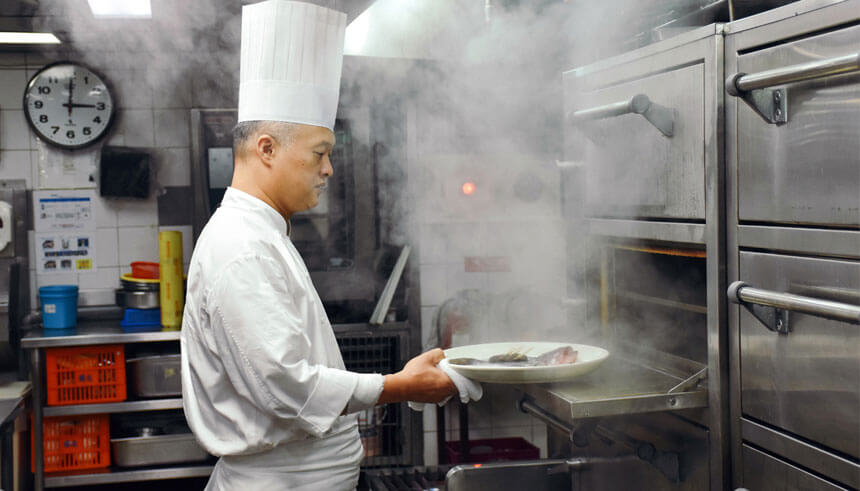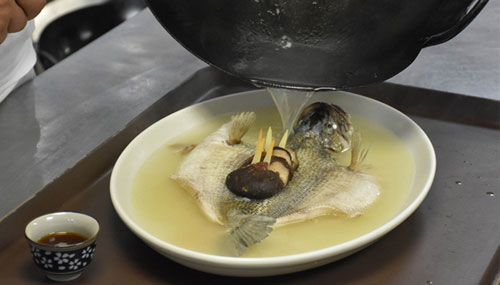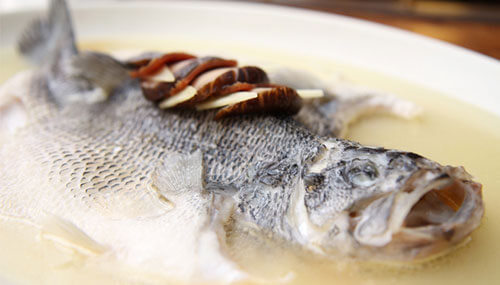East West Lifestyle
Recipes of Asia: New Year’s Steamed Bass with Aged Wine
By Clarissa Wei

Clarissa Wei celebrates Chinese New Year with whole fish to usher in good tidings.
Spring is on its way, and once again, Chinese New Year is here—a time where billions of people across Greater China head home for days of feasting and family reunions. Chinese New Year is the biggest holiday in China, and food is foundation of the festivities. Symbolism is an integral part of this. Certain foods are chosen for their auspiciousness and are believed to help usher in good luck for the upcoming year.
I collected this recipe from Yun Jin, one of nine restaurants at the Grand Hyatt Hotel in Taipei. Yun Jin is a traditional Chinese restaurant specializing in Northern, Sichuan and Jiangnan cuisine. “We have basically everything except Cantonese food,” says Eli Li, the assistant manager of public relations at the Grand Hyatt. “There’s another restaurant in the hotel dedicated to just that.”
The steamed bass is a classic in the Jiangnan region of China, which refers to the southern reaches of the Yangtze River. It’s a dish that comes from Lake Tai—China’s third-largest freshwater lake. Fish, in Chinese New Year tradition, has lucky associations. The associated saying is nian nian you yu (年年有餘 or 年年有魚). The word yu is a homophone for both fish and surplus. The idea is to leave a bit of fish leftover to usher in surplus. A whole fish is required, which symbolizes unity. Many people consider it taboo to flip over a fish when eating it, because it exemplifies a toppled family. Of course, different families hold different degrees of superstitions when it comes to their food.

Still, fish is a motif across most Chinese families during the New Year—especially those with ancestral ties to the southern river regions.
“Here in Taiwan, we get a spring bass from Hsinchu County. It’s a fleshy white fish that’s almost as delicate as the varieties found at Lake Tai,” says Chef Ben Hsieh, who has been with Yun Jin since 1999. His recipe is purposefully simplistic. Ginger and shiitake mushrooms add savory depth to a naturally sweet fish. The only other flavor components are a dash of salt, Jinhua ham and the Shaoxing wine, a yellow Chinese rice wine that is aged for 10 or more years and tastes similar to dry sherry. The ingredients are named after cities in the Zhenjiang province, bordering Lake Tai, in the Jiangnan region of China.
For the Shaoxing wine, Hsieh prefers using Nu Er Hong, a specific Chinese brand of aged Shaoxing wine that comes with a colorful past. The wine, which translates to “red daughter” in English, would customarily be buried underground when a daughter was born, dug up when she was about to be married, and served at the wedding banquet.
“There are three steps to eating this dish.” Hsieh says. “First, take a sip of the broth and note how the natural sweetness of the fish has merged with the chicken broth. Second, try the flesh of fish with the Shaoxing wine poured over it. You can really take in the aromatics of the wine. Third, eat the fish with a scoop of chicken broth. That’s when you can fully appreciate in the complexity of the flavors.”

The wonderful part of this dish is that’s remarkably easy for the home cook to accomplish. It only takes 15 minutes to whip up. Filleting the fish isn’t mandatory, though Hsieh highly recommends it. Here are the instructions:
Steamed Bass with Aged Wine
Cooking time: 15 minutes
Serves: 2
Ingredients:- 1 bass or perch
- 1 shiitake mushroom
- 1 inch knob ginger
- 1 1/2 inch Jinhua ham or any dry-cured ham
- 4 tbsp Shaoxing wine (specifically, the Nu Er Hong brand 女兒紅酒, or substitute with dry sherry)
- 2 1/2 cups chicken broth
- Salt
- Gut and partially filet the fish, so that the bottom flares out. Remove bones and organs. Rub a thin layer of salt around the fish and let it sit for a couple of minutes.
- Place the fish on a steamer plate.
- Slice mushroom, ginger, and ham into thumbnail pieces and place on top of the fish.
- Steam the fish for seven minutes.
- Take a deep wok and turn the heat up to high. When searing hot, put in the chicken broth for about 30 seconds, so that the broth is hot. Add 2 tsp of salt. Stir.
- Ladle the broth over the fish.
- Add Shaoxing wine on top of the fish.
- Serve.
Yun Jin at Grand Hyatt Taipei: 2nd floor, No. 2, Songshou Road, Xinyi District, Taipei City, 110
Subscribe to the Reach Further Newsletter
Get inspiring stories in your inbox every month.

